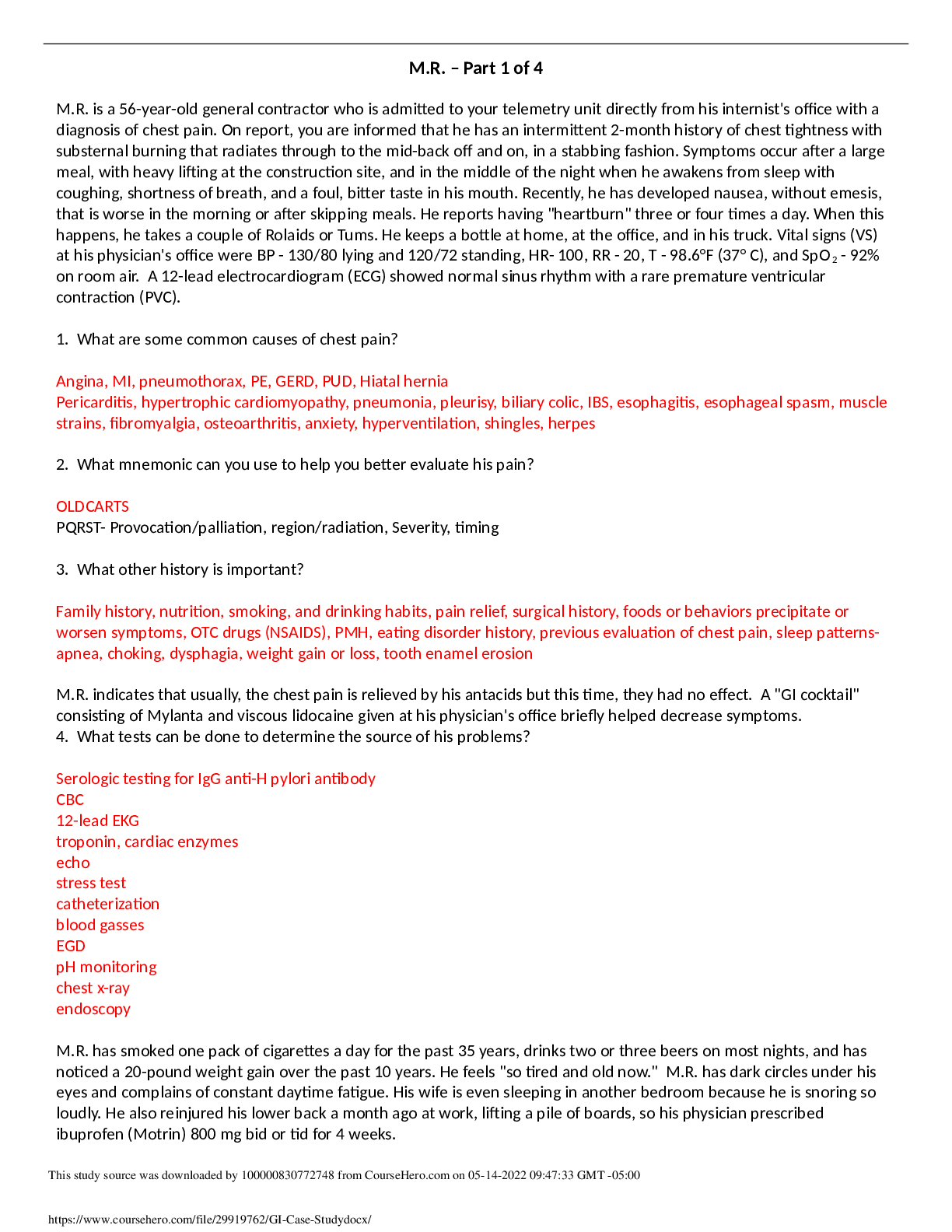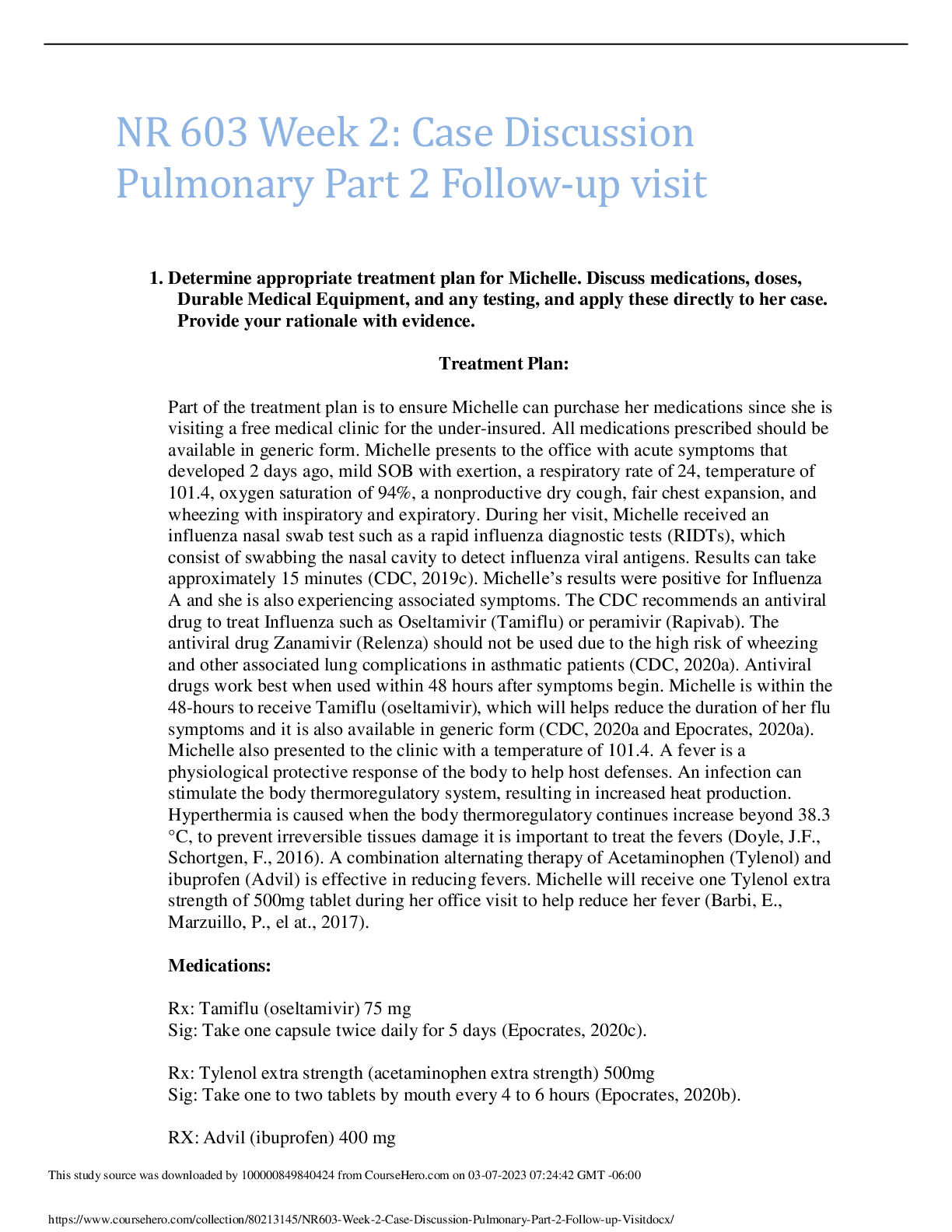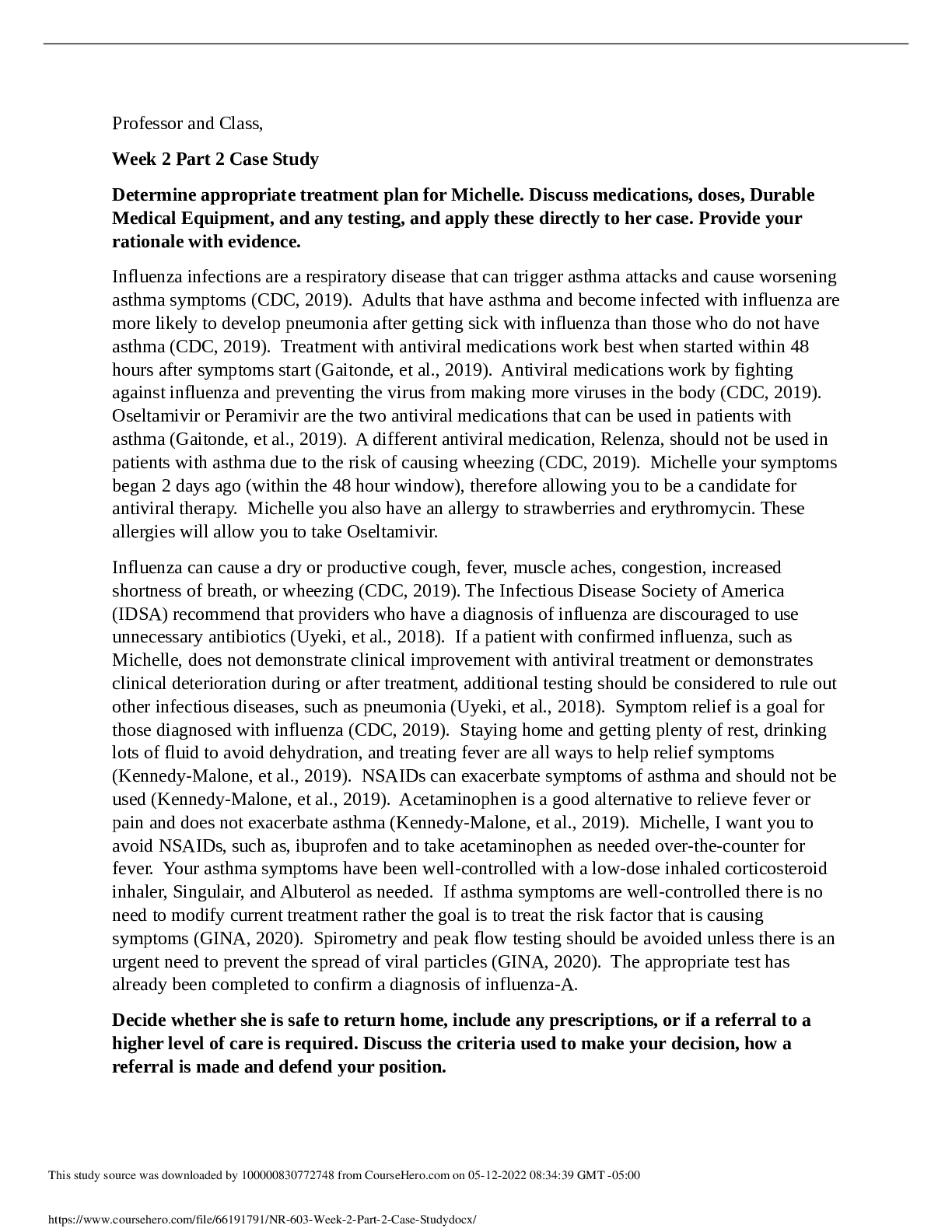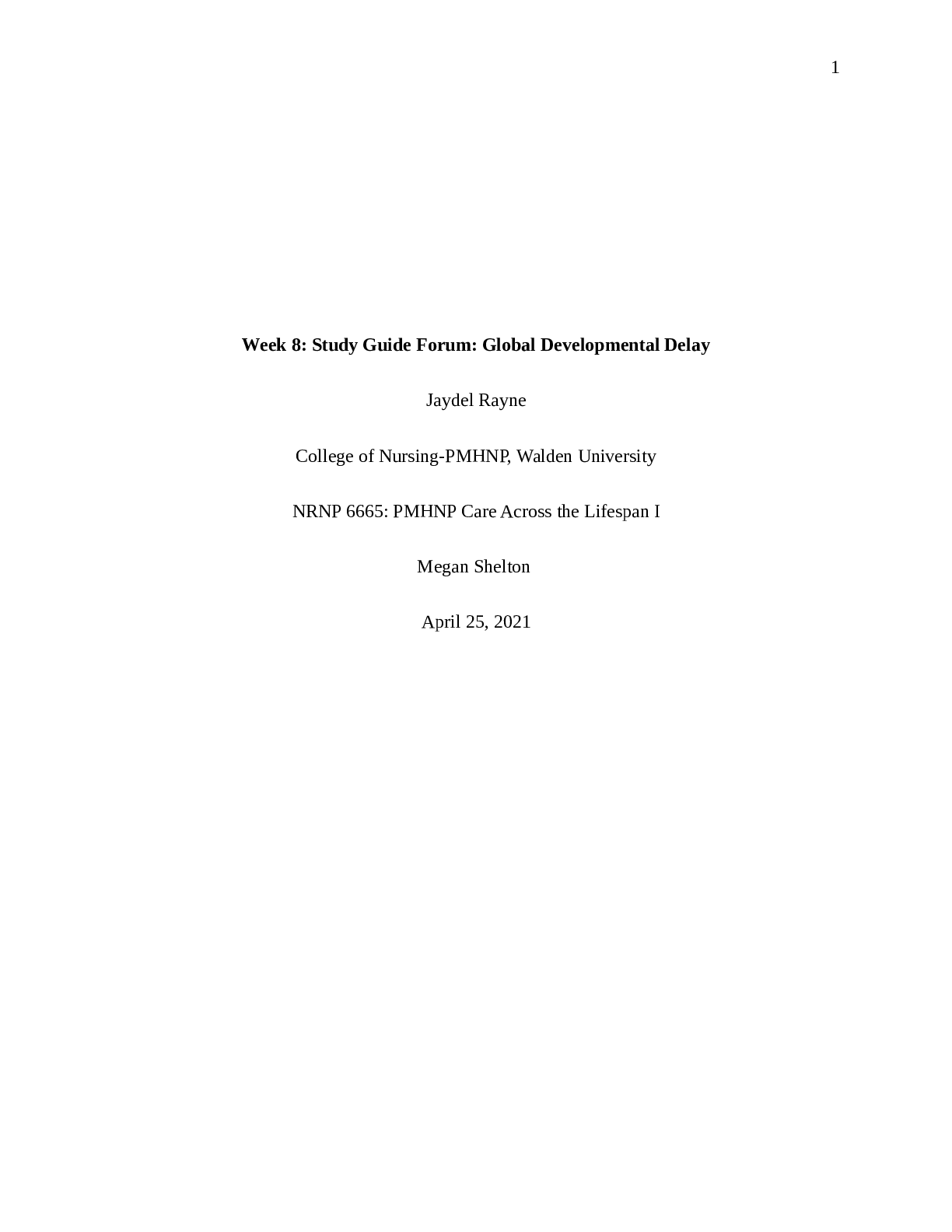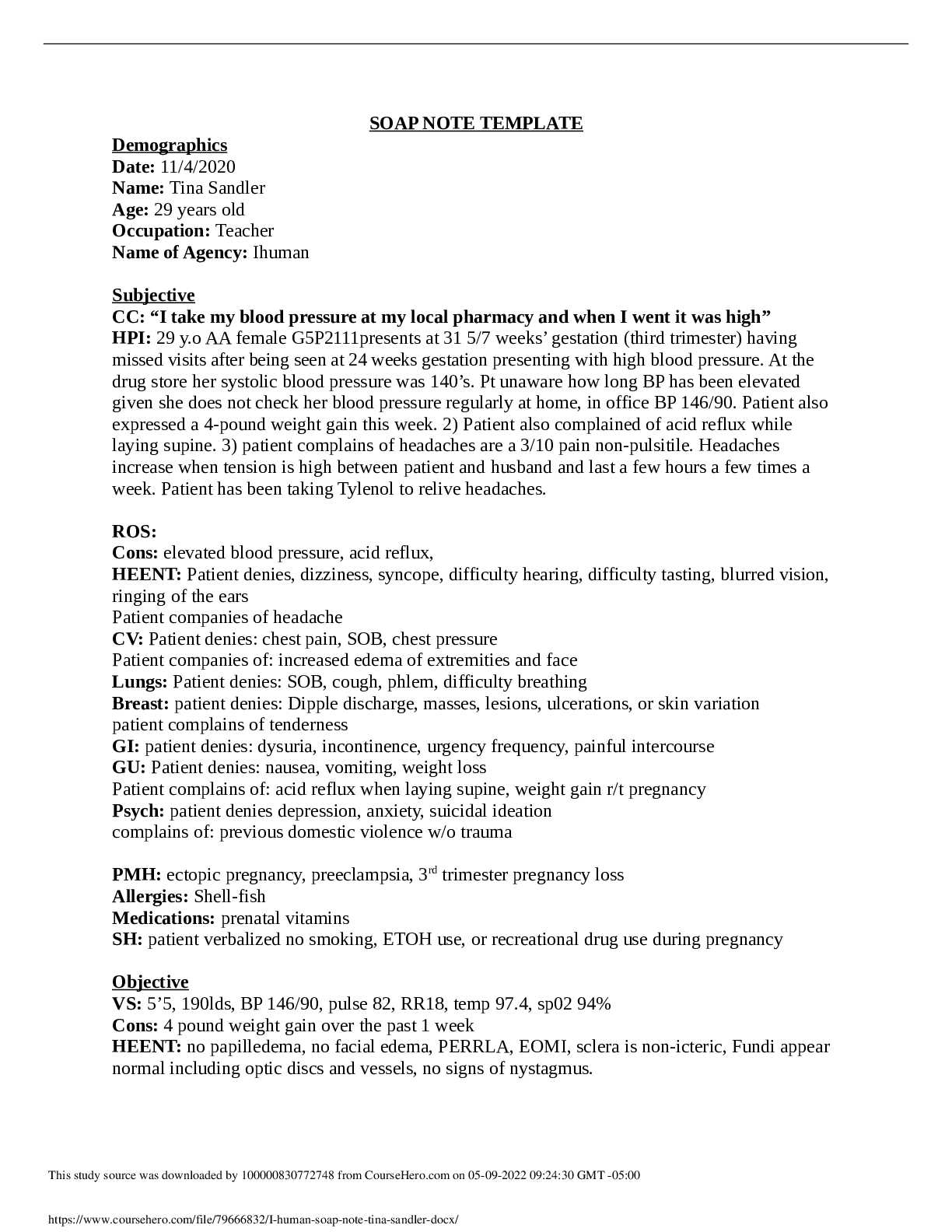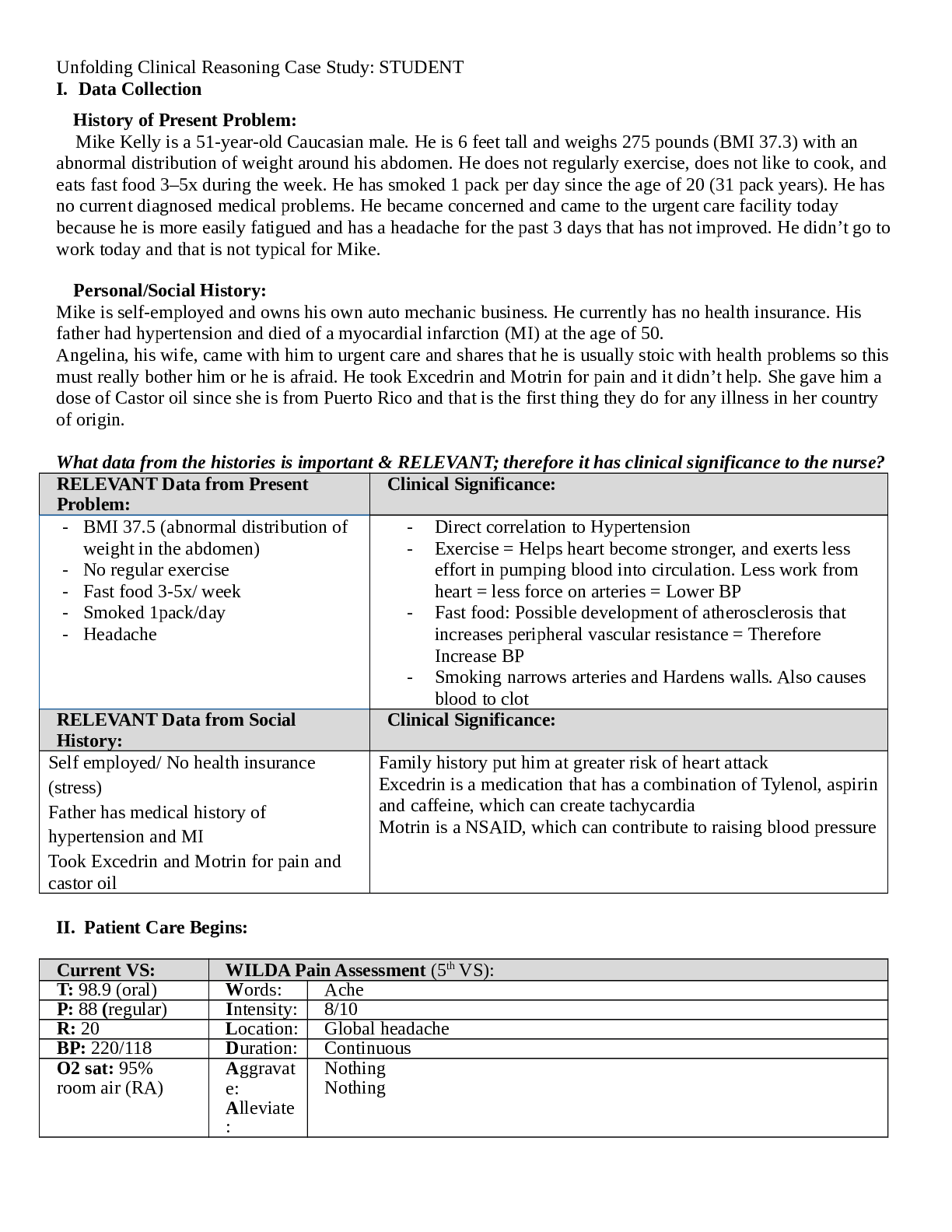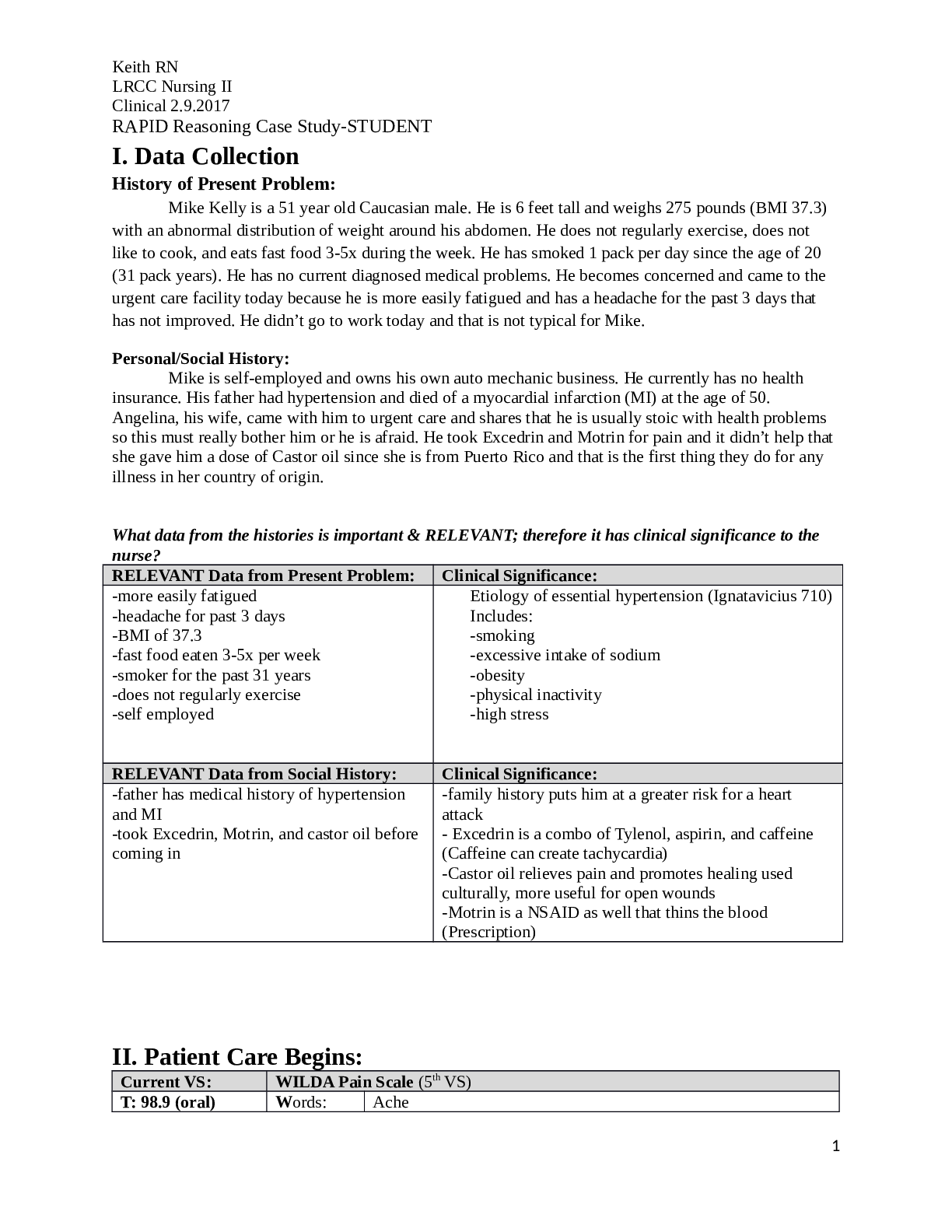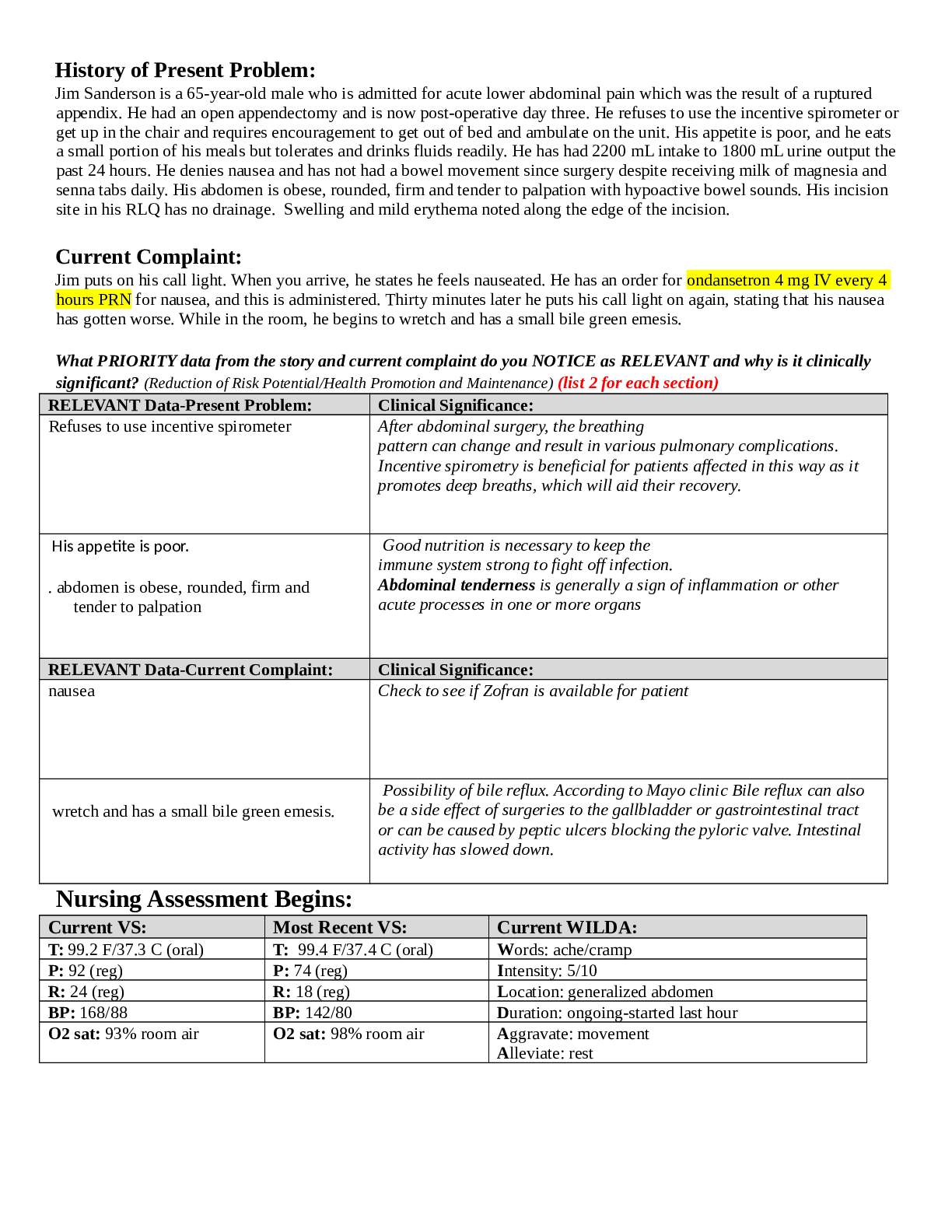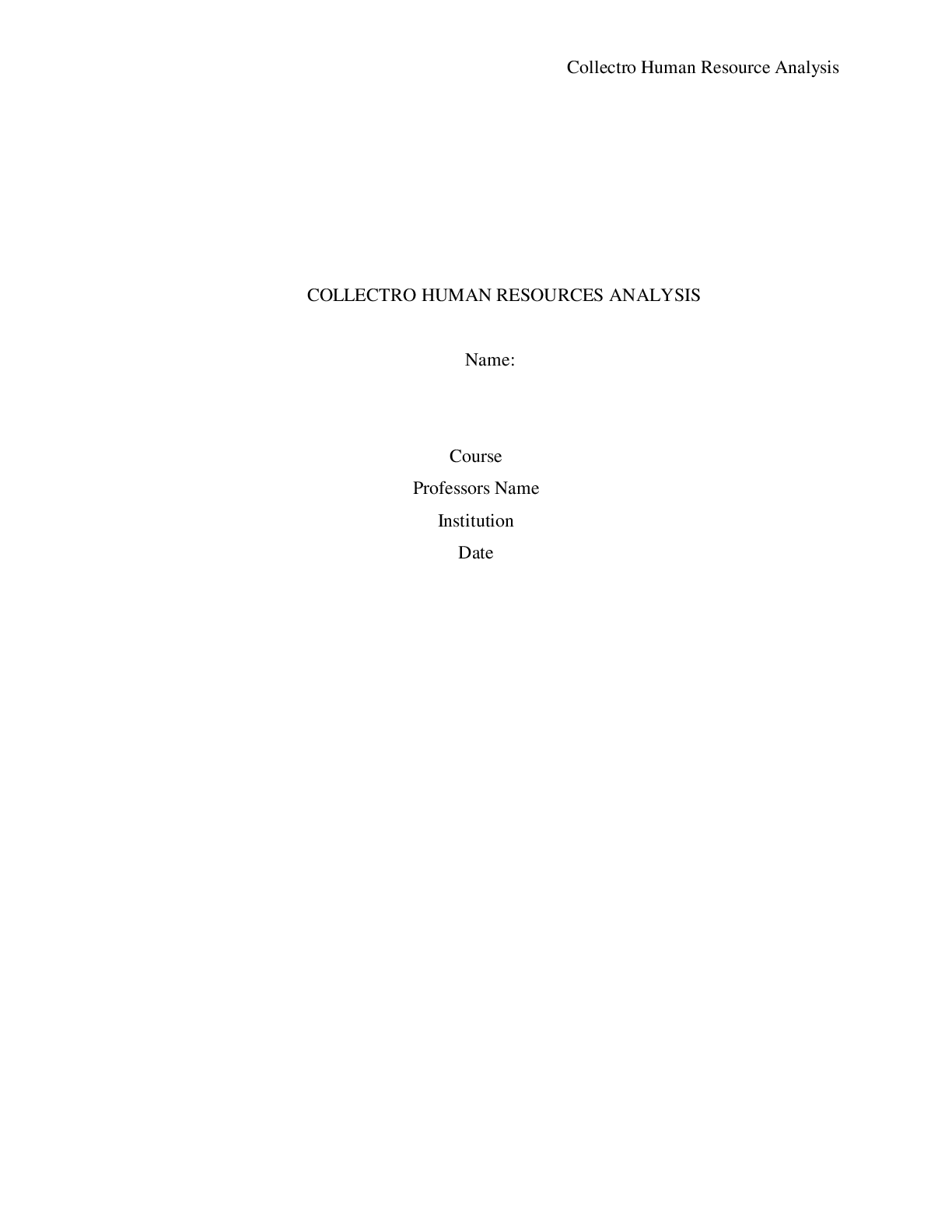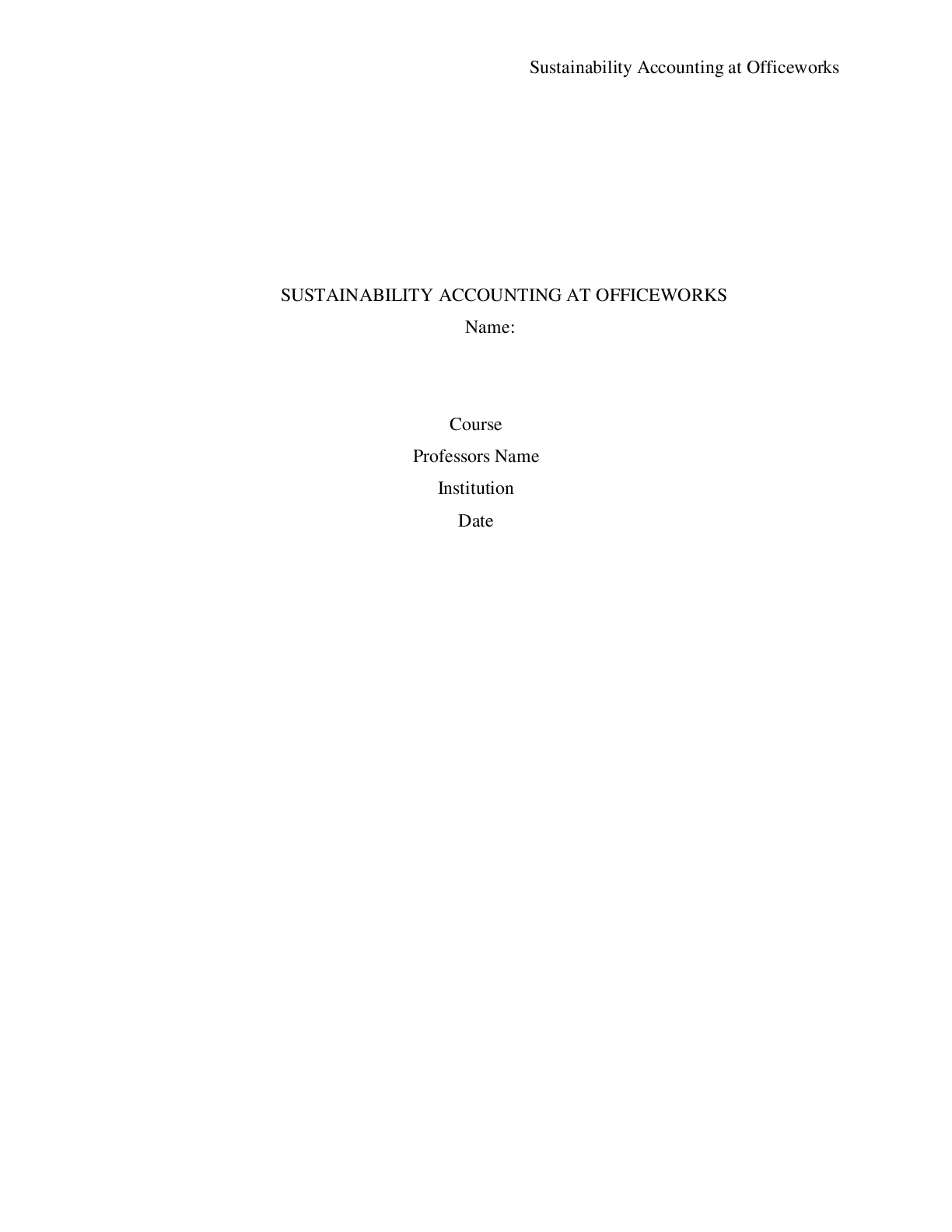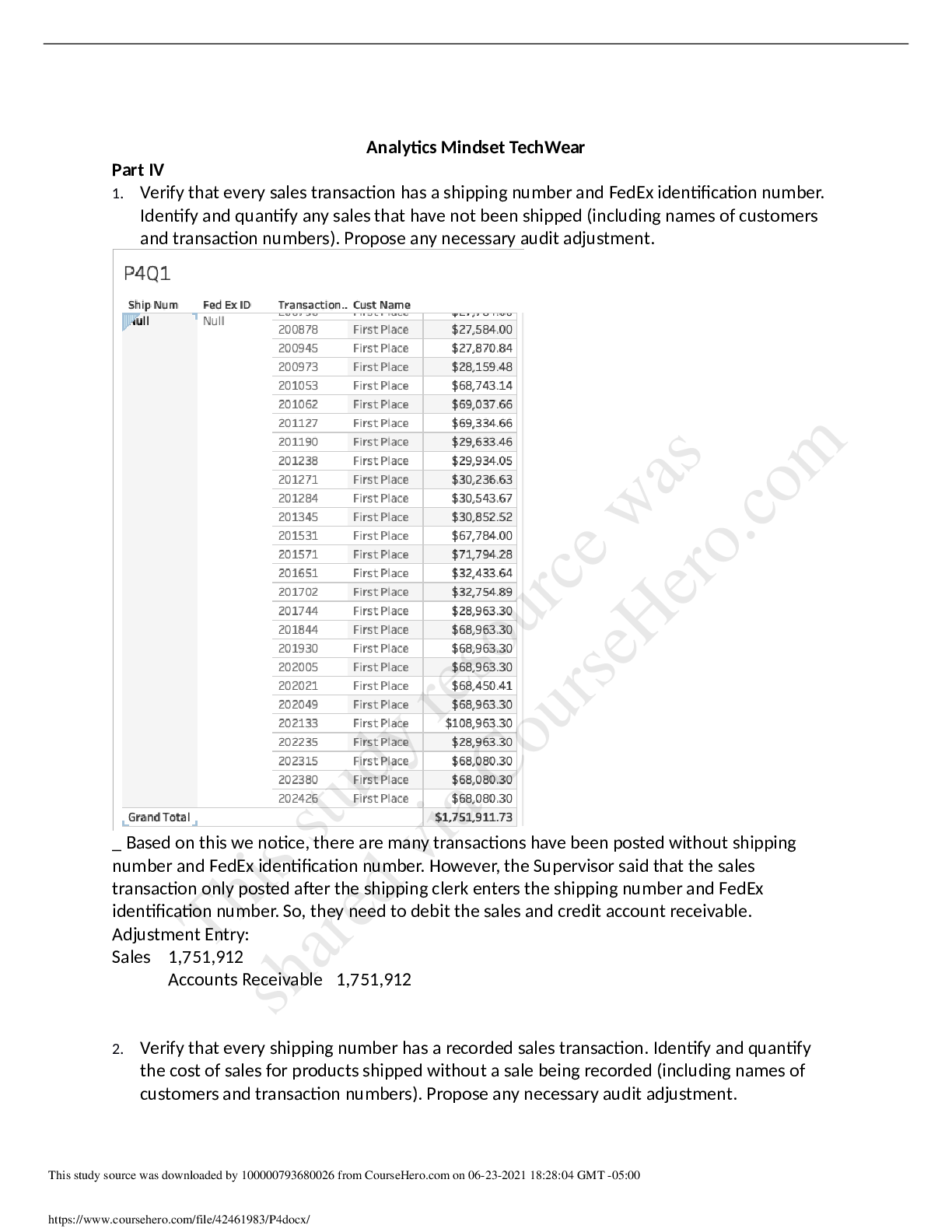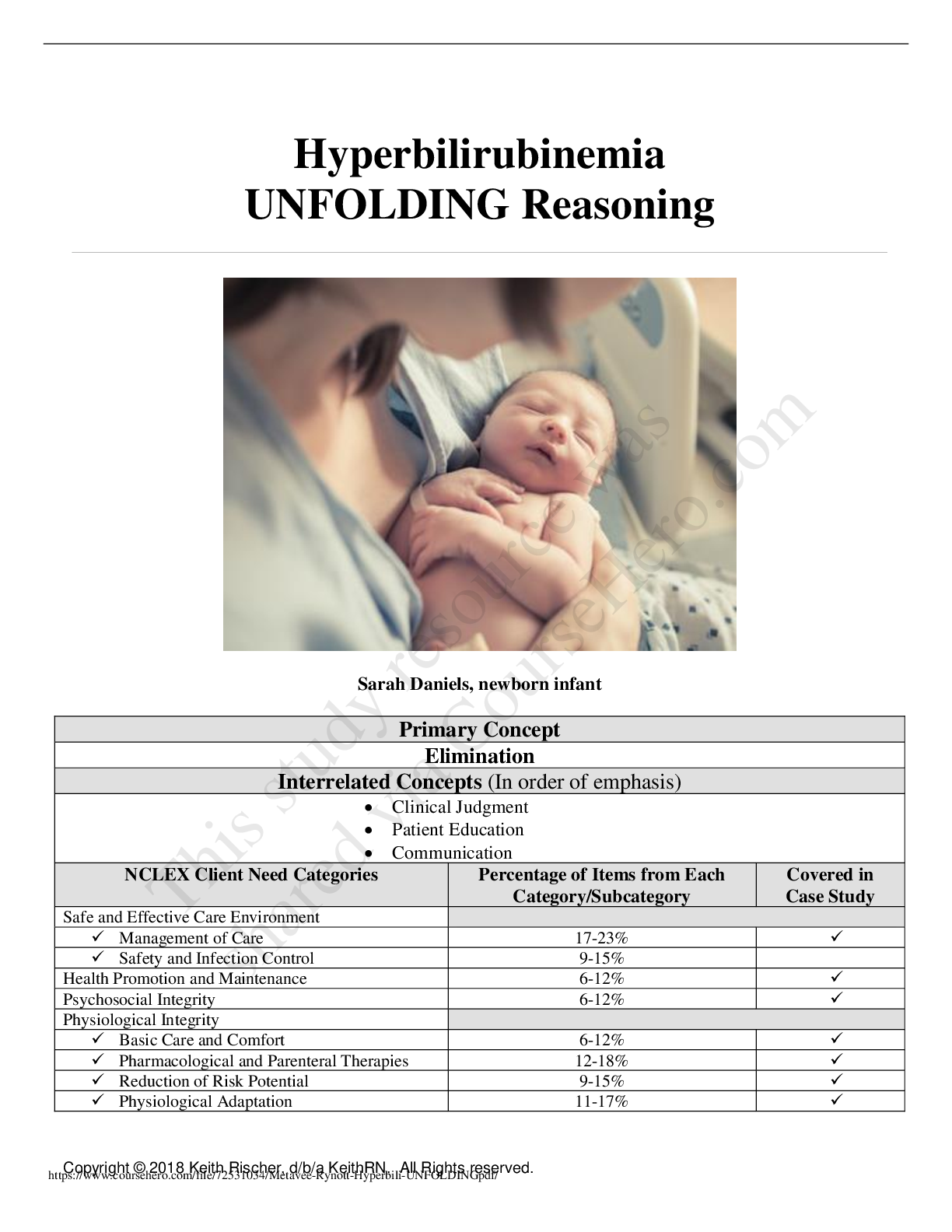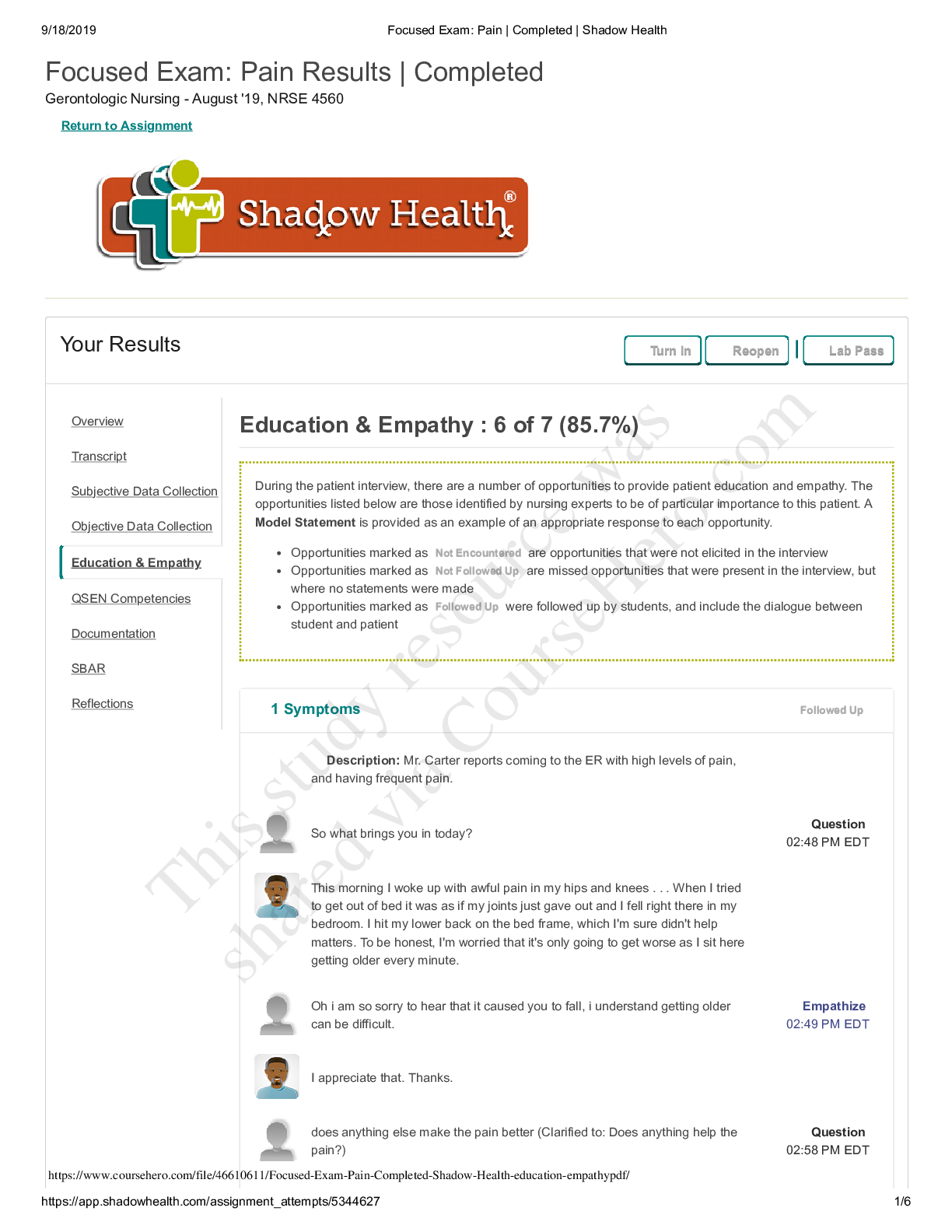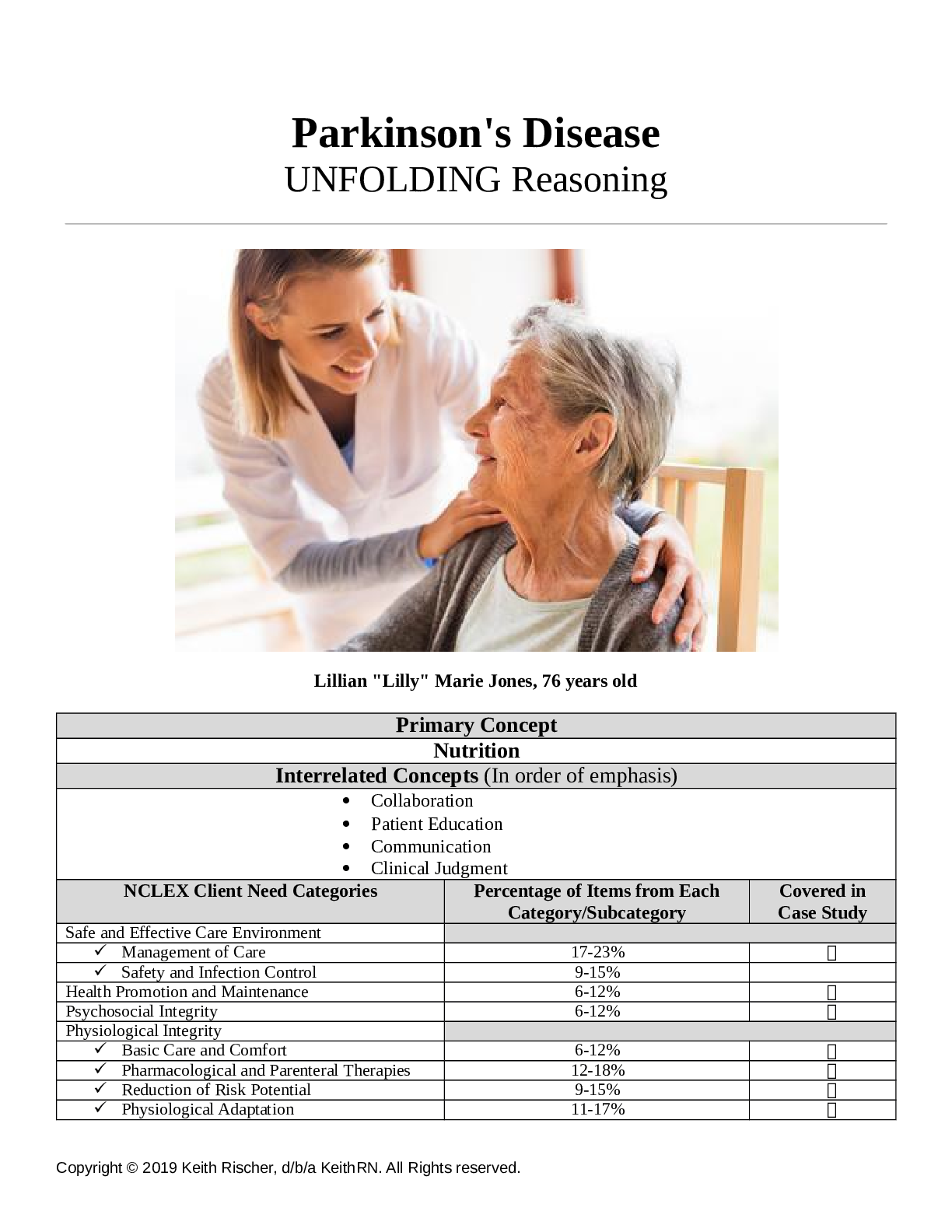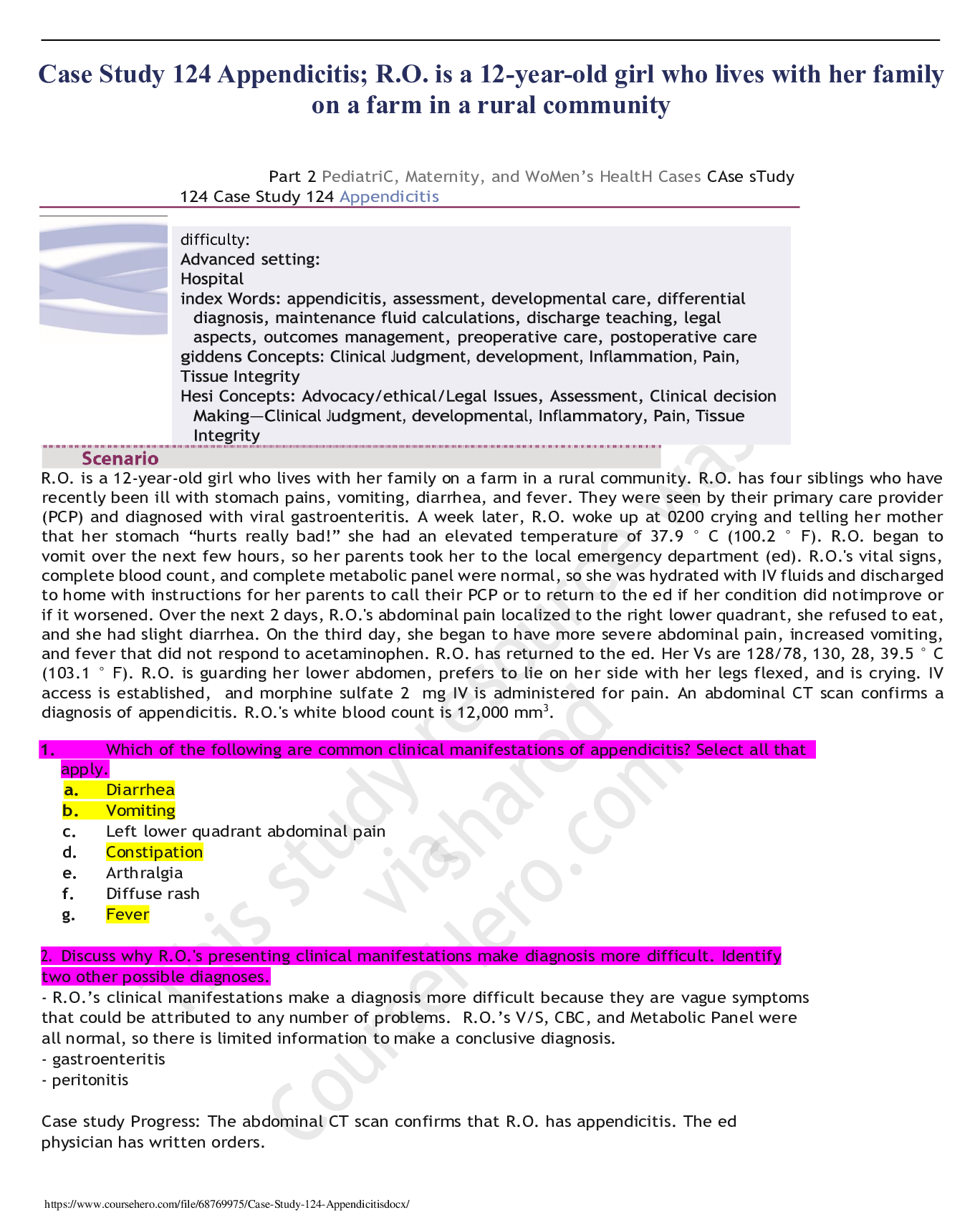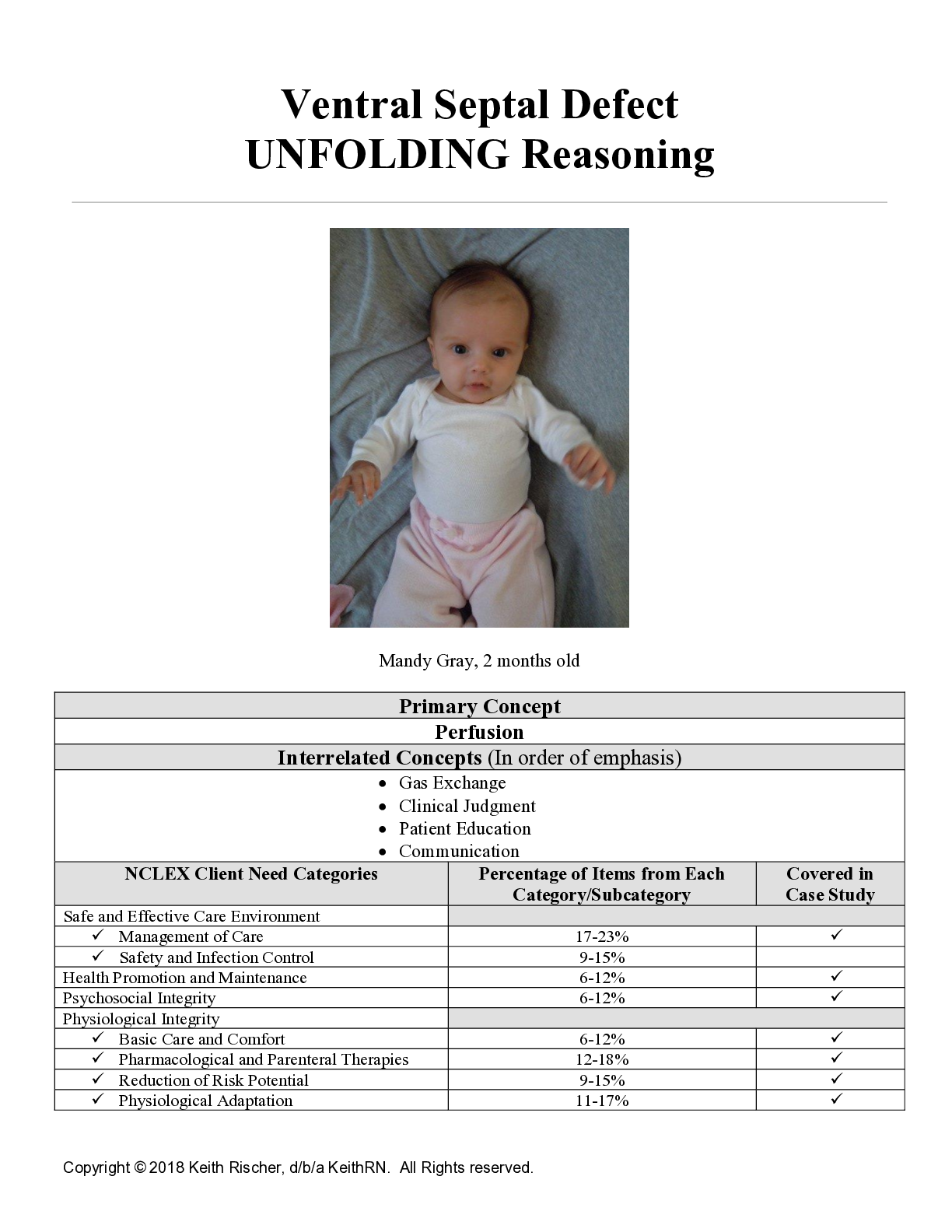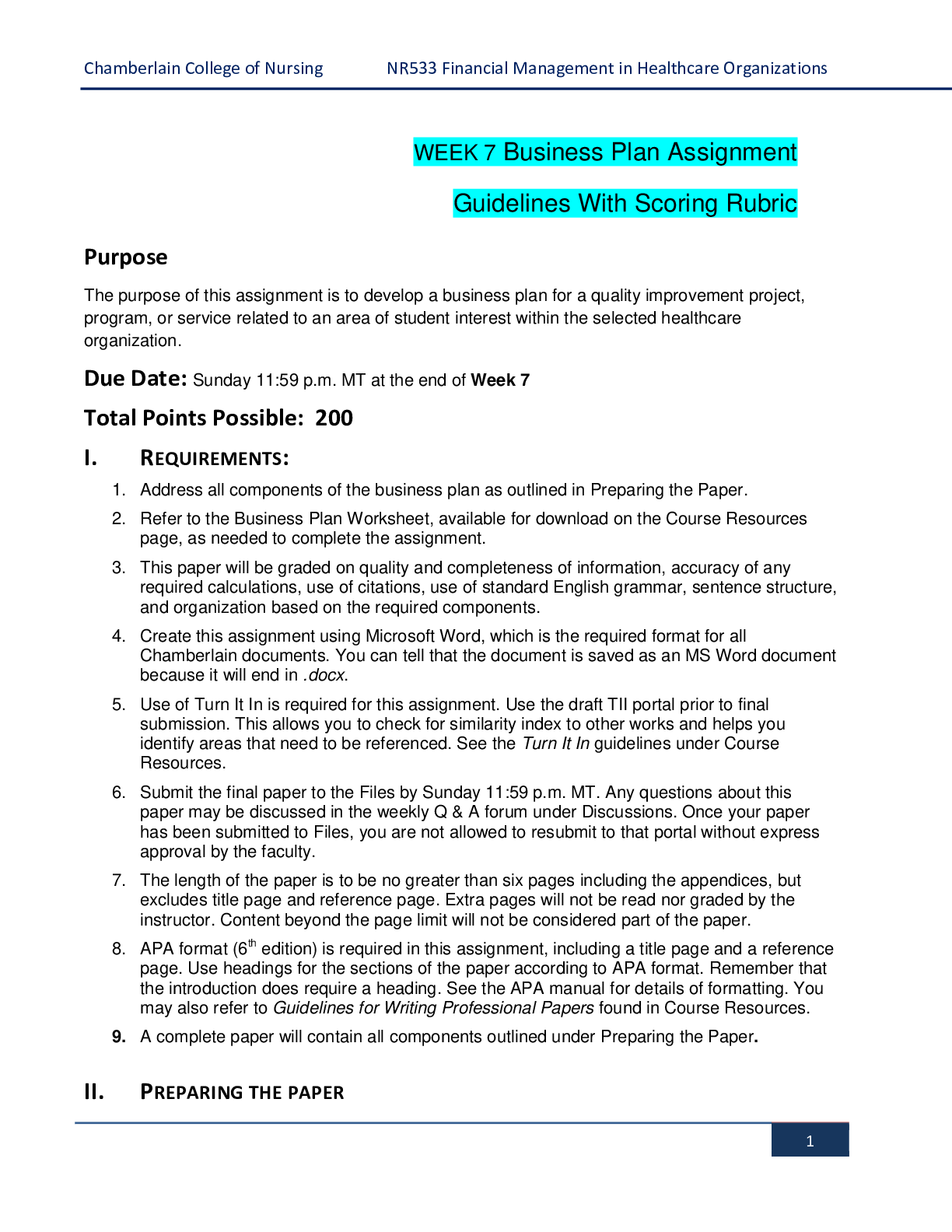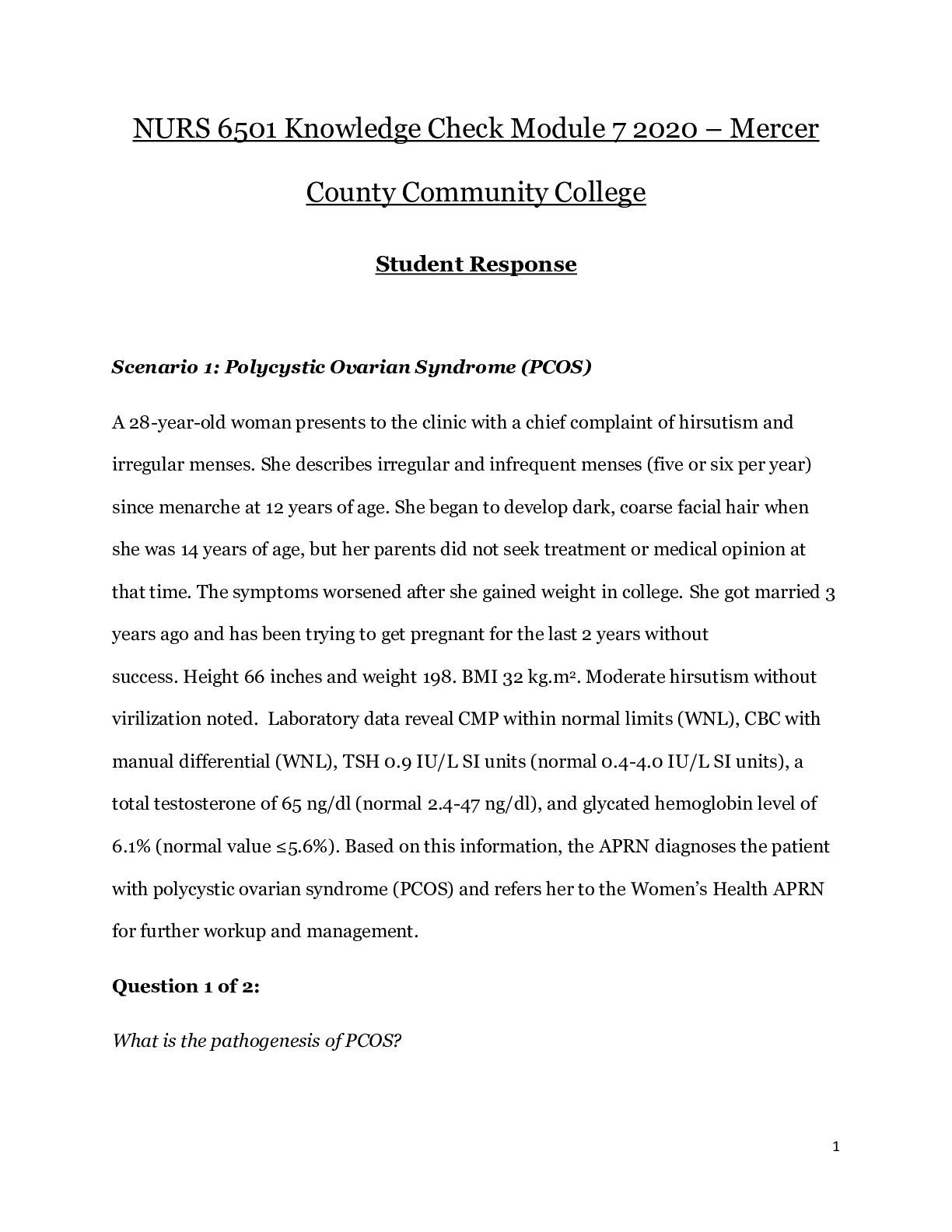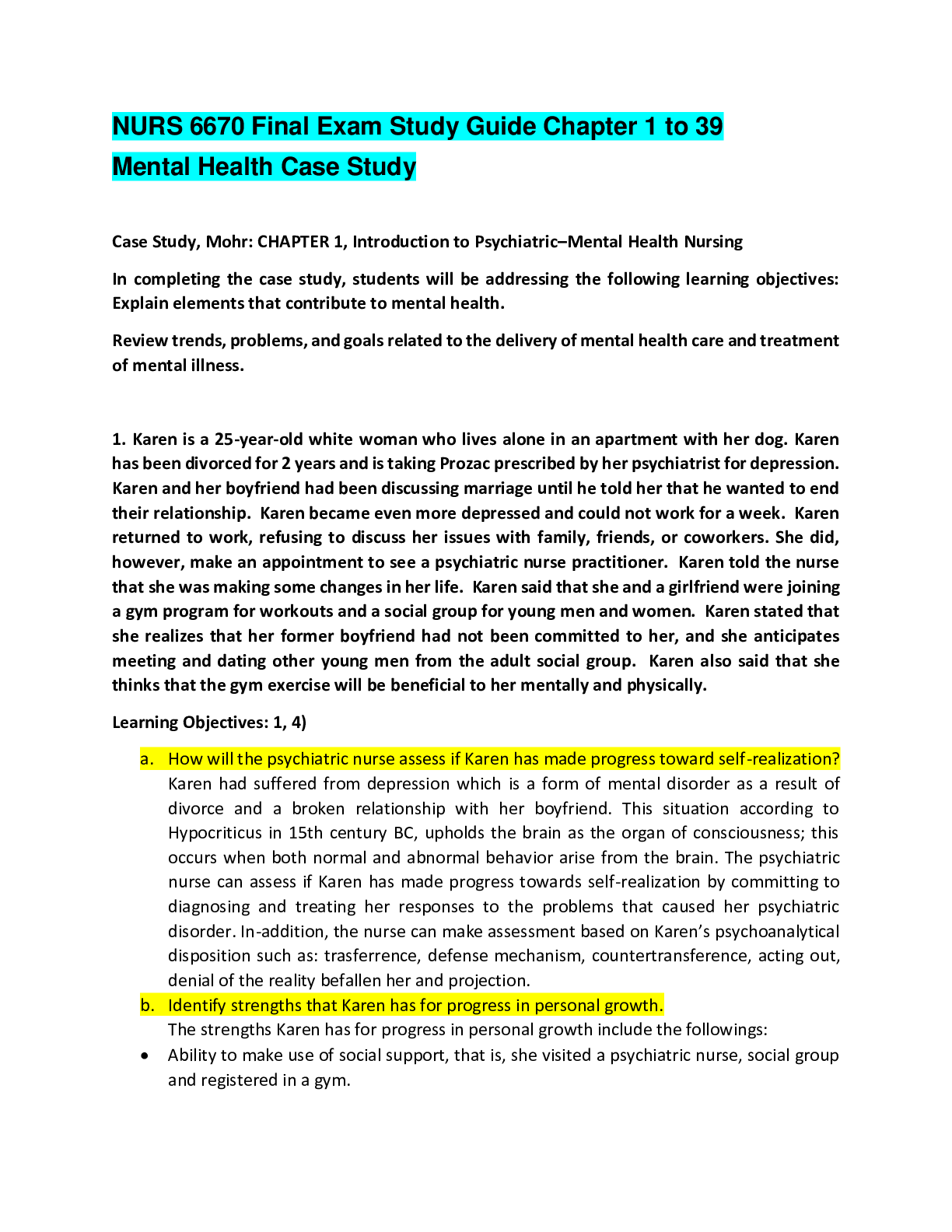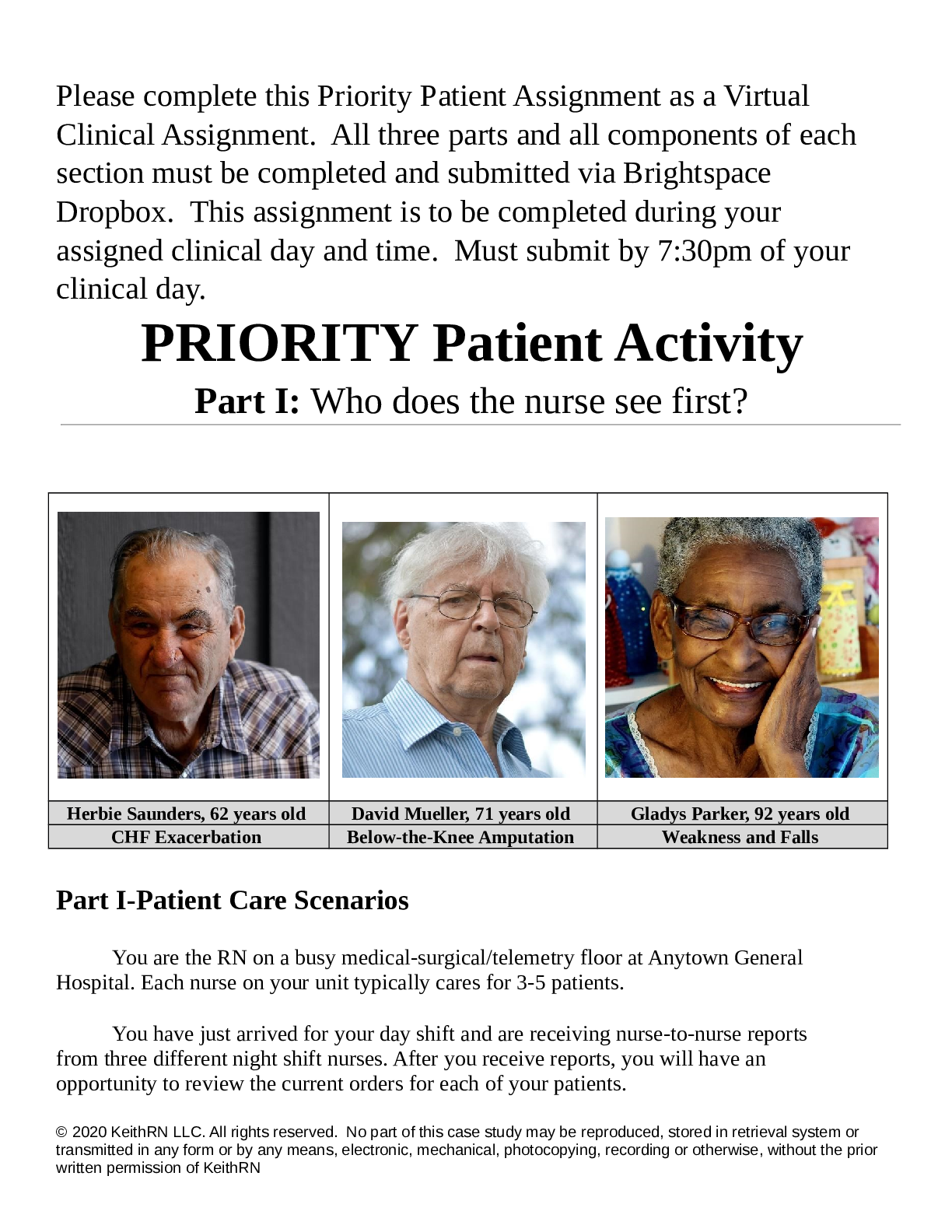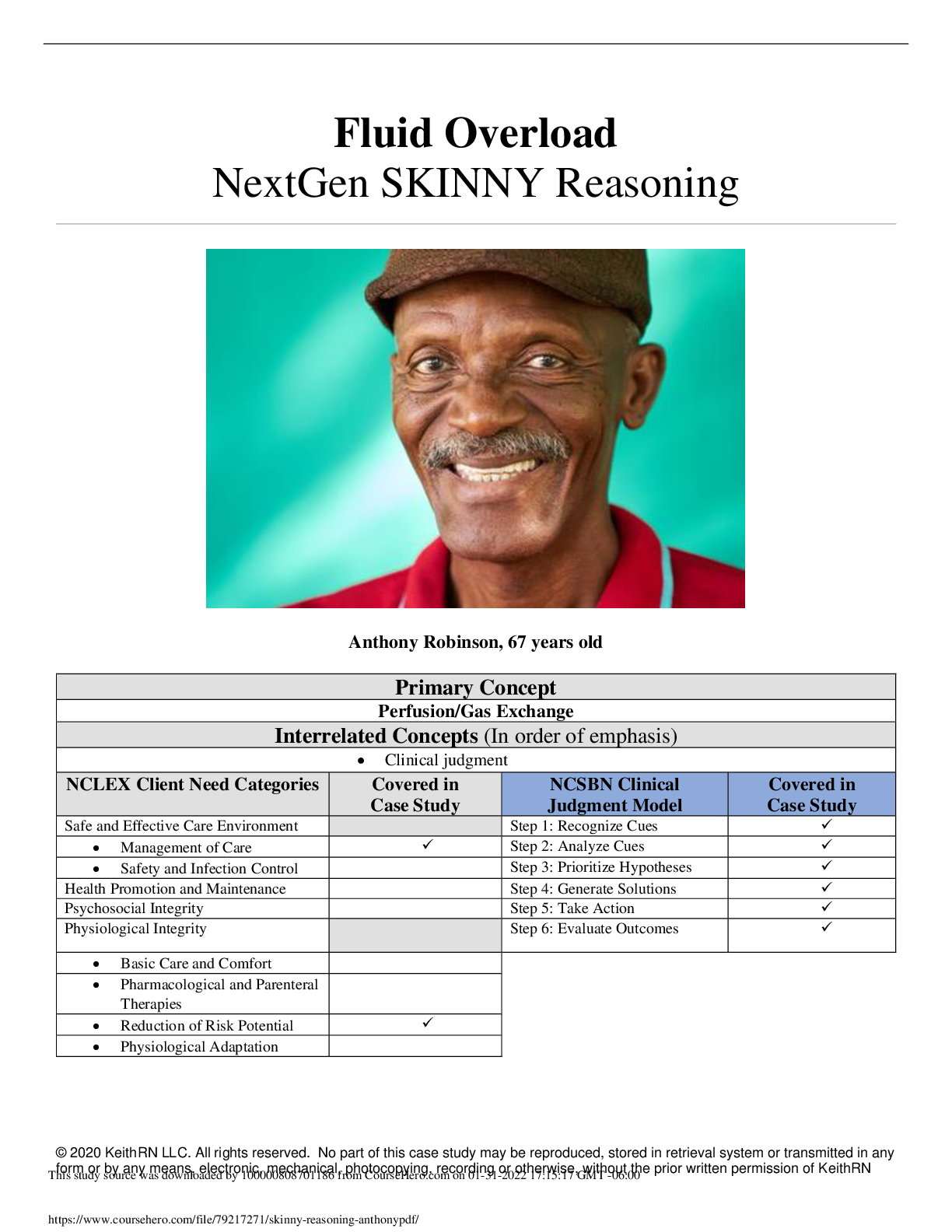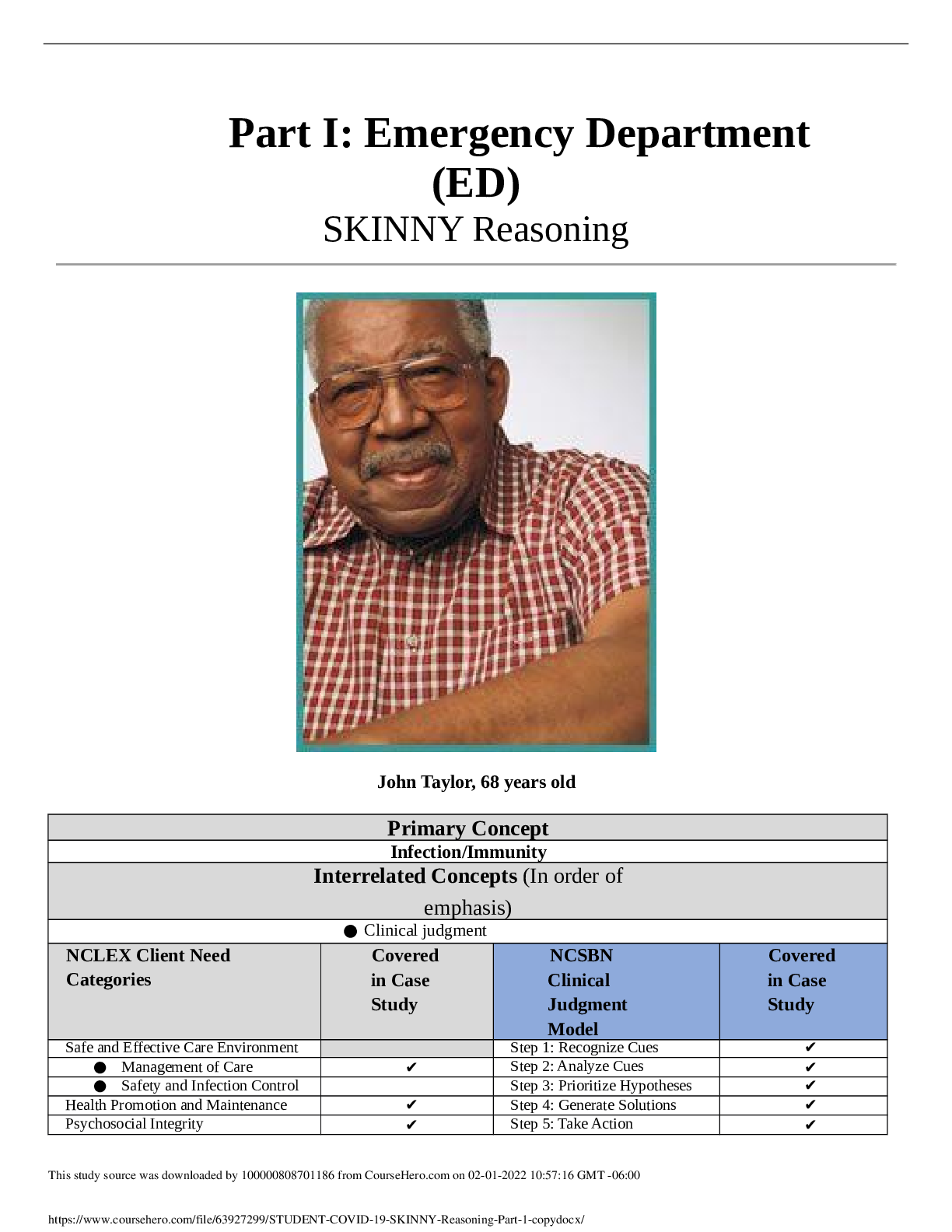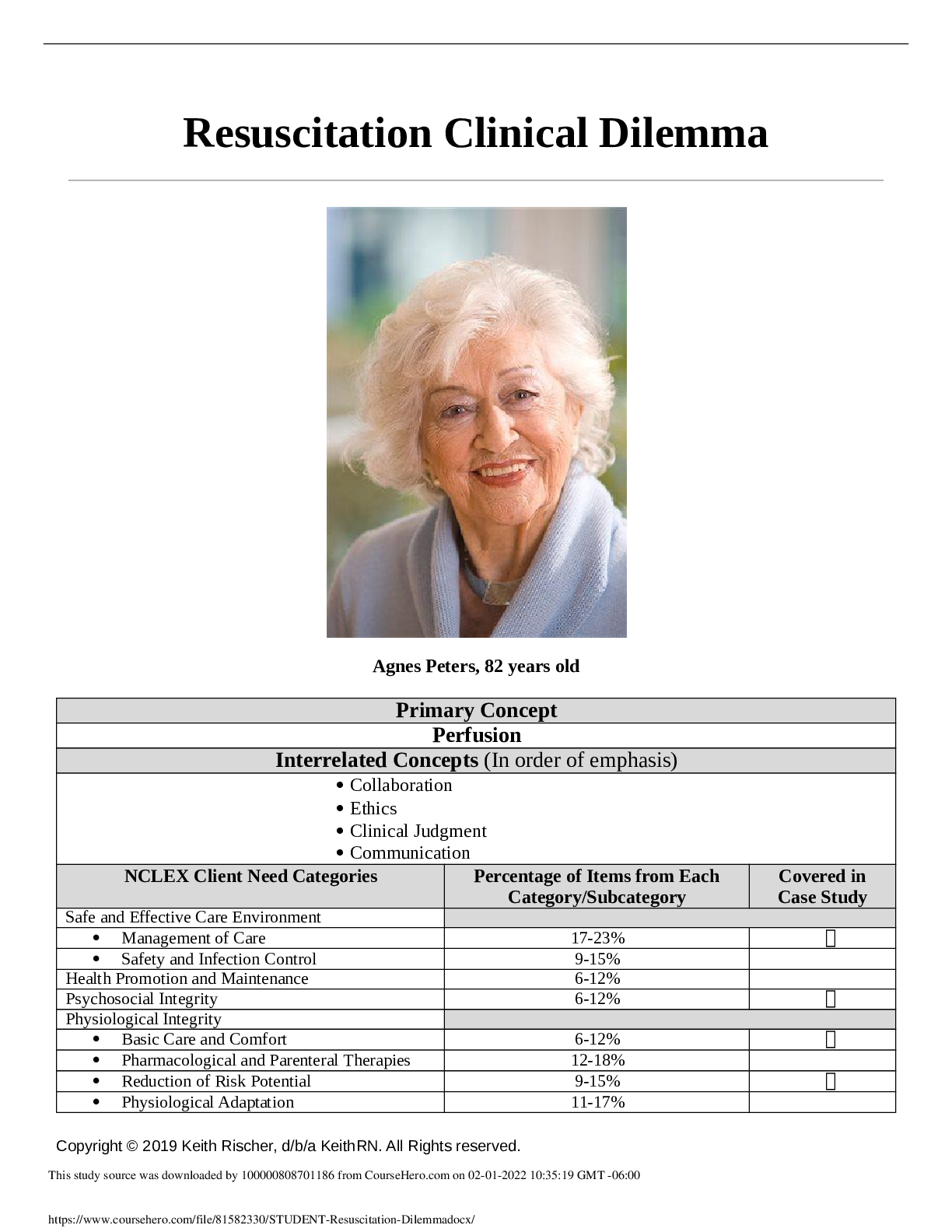Health Care > CASE STUDY > Endocrine case study answers (All)
Endocrine case study answers
Document Content and Description Below
You work in the diabetes mellitus (DM) center at a large teaching hospital. The first patient you meet is K.W., a 25-year-old Hispanic woman, who was just released from the hospital 2 days ago after... being diagnosed with type I DM. Nine days ago, K.W. went to see the physician after a 1-month history of frequent urination, thirst, severe fatigue, blurred vision, and some burning and tingling in her feet. She attributed those symptoms to working long hours at the computer. Her random glucose level was 410 mg/dL. The next day her laboratory values were as follows: fasting glucose 335 mg/dL, hemoglobin A1C (HbA1c) 8.8%, cholesterol 310 mg/dL, triglycerides 300 mg/dL, high-density lipoprotein (HDL) 25 mg/dL, low-density lipoprotein (LDL) 160 mg/dL, ratio 12.4, and creatinine 0.9 mg/dL. Her body mass index is 37.6. Her blood pressure (BP) is 160/96 mm Hg. She was admitted to the hospital for control of her glucose levels and the initiation of insulin therapy with carbohydrate (CHO) counting. After discharge, K.W. has been referred to you for comprehensive education. You are to cover four basic areas: pharmacotherapy, glucose monitoring, medical nutrition therapy (MNT), and exercise. 1. K.W. was started on sliding scale lispro (Humalog) four times daily and glargine (Lantus) insulin 30 units at bedtime. What is the most significant difference between these two insulin therapies? The difference is their onset, peak, and duration. Lispro is a fast-acting insulin analogue with an onset of action within 15 minutes, a peak effect of ½ to 1 hour, and a duration of 3 to 4 hours. Patients using lispro are cautioned not to take it until they sit down to eat or no sooner than 10 minutes before eating. Food intake must match insulin administered to avoid hypoglycemia. The short duration necessitates frequent administration. Glargine (Lantus) is basal insulin with no peak effect and a longer than 24-hour duration of action. The risk of hypoglycemia is minimal. Its long duration allows for once daily injection. 2. K.W. says she knows people who “only take 2 shots” because they are on NPH and regular insulin and wants to know why she can't do that. Explain the advantages of using the glargine (Lantus) and lispro (Humalog) insulin regimen. The most effective insulin regimen, with the best glycemic control, is the one that most closely mimics normal insulin production by the body—the basal-bolus regimen, using lispro, a bolus insulin, before meals and a long-acting basal background insulin once or twice a day. Other advantages to this regimen are less weight gain and less nocturnal hypoglycemia because glargine insulin provides steady-state coverage. 3. What specific points would you include regarding managing insulin therapy? Select all that apply. a. Store unused insulin in the freezer. This study source was downloaded by 100000830772748 from CourseHero.com on 05-14-2022 09:58:14 GMT -05:00 https://www.coursehero.com/file/29919654/Endocrine-case-study-answers-1docx/ b. The insulin can be used if it is yellow but not expired. c. Administer the lispro (Humalog) within 15 minutes of eating. d. Ideally, the glargine (Lantus) should be administered at bedtime. e. Always administer the injections in the same, easy-to-reach location. f. The current vial of lispro (Humalog) can be kept at room temperature for 1 month. g. Two injections will be needed to administer lispro (Humalog) and glargine (Lantus). Answers: c, d, f, g Insulin sites are rotated to prevent lipodystrophy, which results in the uneven absorption. Instruct the patient to rotate sites within the same general location for about 1 week before moving to a new location. Glargine (Lantus) is always administered as a separate injection and not mixed with any other insulin because it has a different pH that makes it incompatible. Ideally, glargine (Lantus) should be administered at bedtime. Insulin vials that the patient is currently using can be left at room temperature for up to 4 weeks unless the room temperature is higher than 86 ° F, or below freezing. Because heat and freezing alter the insulin molecule, vials should be kept out of direct sunlight and never be frozen. Expired or discolored insulin should not be used. Give insulin lispro (Humalog) approximately 15 minutes before meals because of its quick onset of action. 4. Identify important content to review regarding glucose monitoring. • Review the importance of self-monitoring of glucose levels. It provides feedback for meeting and maintaining target glucose levels, detecting or preventing hypoglycemia, and evaluating response to types of food and activity. • Teach her how often and when to monitor blood glucose levels (before and after meals, at bedtime) as directed to assess response to medication. Have her keep a log of glucose levels; the provider uses these to tailor the treatment regimen. • Assist her in choosing a meter that best meets her needs. Factors to consider are cost of the meter, whether the meter and supplies are covered by insurance or other benefits; her ability to use the meter in terms of dexterity or vision loss; and accuracy of the meter. Review the proper use of the meter. • Teach her how to properly obtain a capillary blood glucose sample. 5. K.W. states that she currently does not exercise at all. What benefits will K.W. receive from participating in an exercise program? Most of the benefits of exercise come from regular, long-term, aerobic activity. Patients should be encouraged to exercise at whatever level they are capable of. Exercise will help control her DM, improving the action of insulin by increasing the number of insulin receptor sites. Muscle activity also improves glucose uptake for energy and improves circulation. Other potential benefits of exercise include reduced weight and body fat, improved strength and work capacity, improved cardiovascular function, decreased risk for coronary artery disease This study source was downloaded by 100000830772748 from CourseHero.com on 05-14-2022 09:58:14 GMT -05:00 https://www.coursehero.com/file/29919654/Endocrine-case-study-answers-1docx/ (CAD) by lowering cholesterol and triglycerides and increasing HDL, and improved well-being and quality of life. 6. What do you need to teach K.W. regarding safe exercise? • Monitor blood glucose before activity. Avoid activity when fasting glucose levels are more than 250 mg/dL and ketones are present and use caution if glucose levels are more than 300 mg/dL with no ketosis. She should ingest added CHOs if glucose levels are less than 100 mg/dL. • Depending on the length of exercise, glucose might need to be monitored during and after activity. • Because hypoglycemia is a risk during or after exercise for those on insulin, she should carry a ready glucose source in case hypoglycemia occurs (hard candy, juice, glucose tablets). CHObased foods should be readily available during and after physical activity. She may need to consume CHOs during exercise to avoid hypoglycemia. 7. K.W. states she and her husband were planning to have another child in a year to two. She wants to know if her DM will affect a pregnancy. Pregnancy in persons with DM is a complex issue. What basic information can you share with K.W. today without overwhelming her? Women with DM have the same fertility rate as women who do not have DM. DM care during pregnancy has improved greatly over the years; however, women with DM and their infants are still at risk for a number of complications. To reduce these risks, it is essential to achieve normal or near normal glucose and HbA1c levels for 3 to 6 months before conception. These levels need to be maintained throughout the pregnancy. In the meantime, she should continue her current contraception methods until she has achieved her glucose goals and is ready to engage in further preconception counseling. 8. What evaluative parameters could you use to determine whether your teaching with K.W. was effective? K.W. will be able to: • Accurately demonstrate self-administration of insulin • Maintain blood glucose, HbA1c, and lipid measurements within normal parameters • Recognize and treat hypoglycemia and hyperglycemia • Be able to accurately monitor blood glucose • Explain rules for safe exercise • Accurately interpret CHO count of a meal [Show More]
Last updated: 1 year ago
Preview 1 out of 4 pages
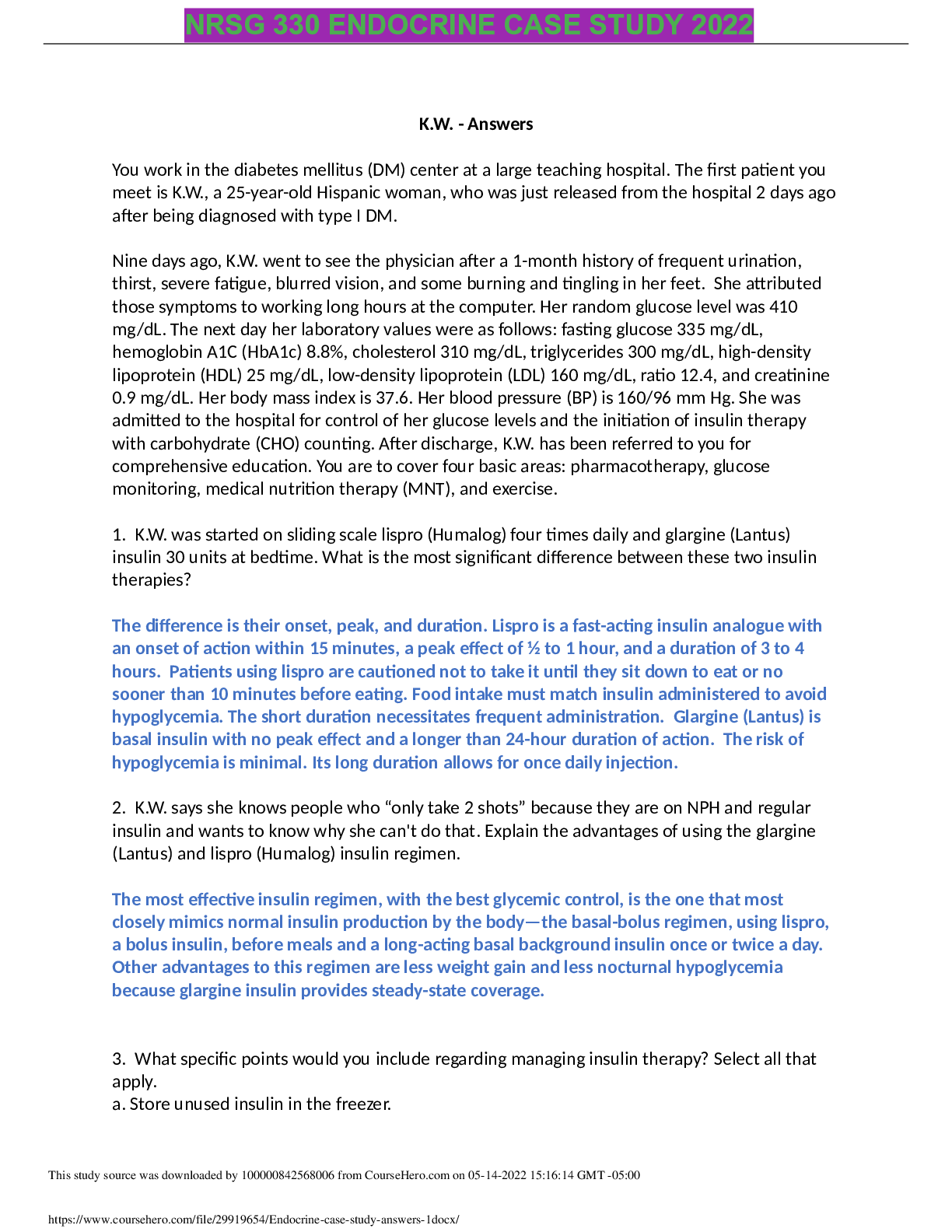
Reviews( 0 )
Document information
Connected school, study & course
About the document
Uploaded On
May 14, 2022
Number of pages
4
Written in
Additional information
This document has been written for:
Uploaded
May 14, 2022
Downloads
0
Views
60

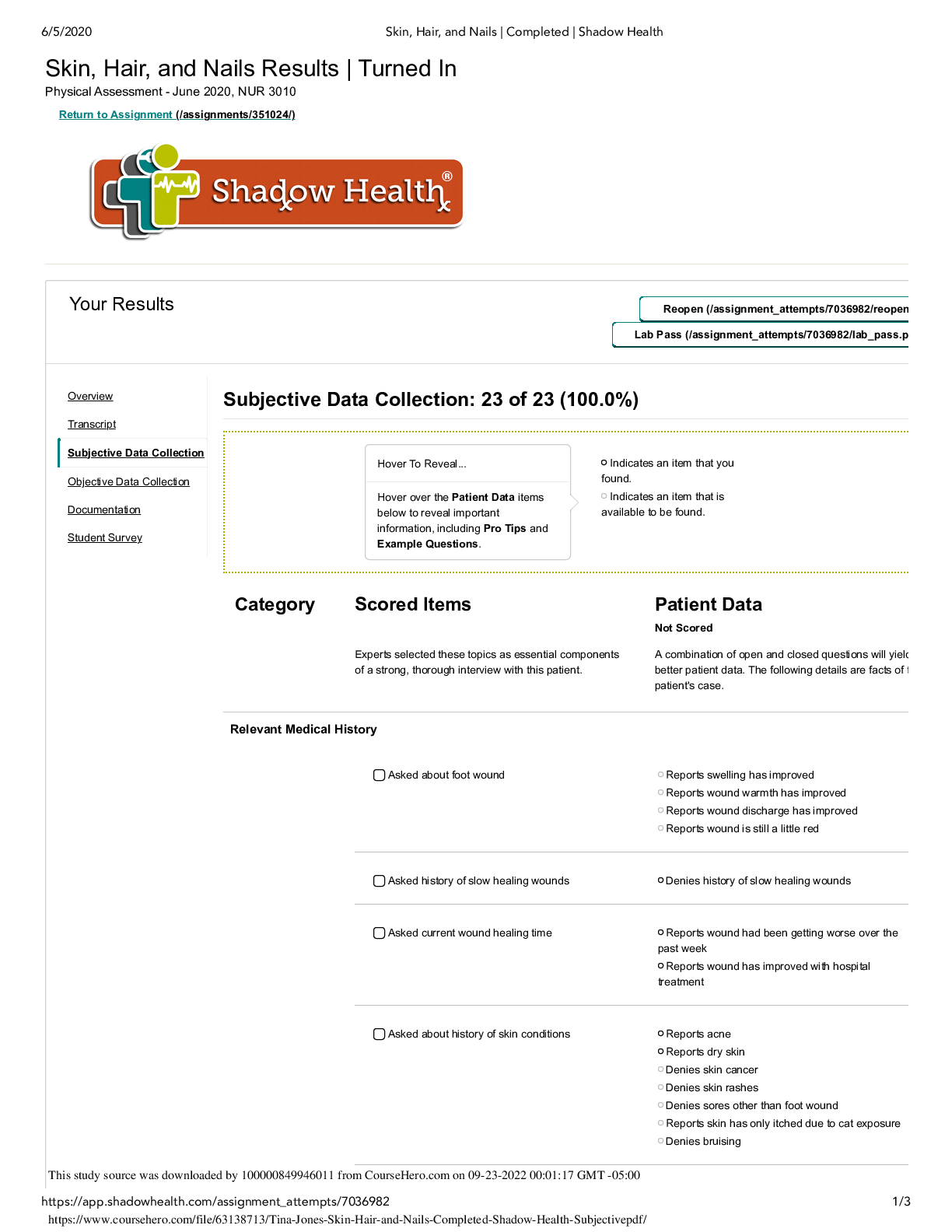
 (1).png)

